Physical Address
304 North Cardinal St.
Dorchester Center, MA 02124
Physical Address
304 North Cardinal St.
Dorchester Center, MA 02124
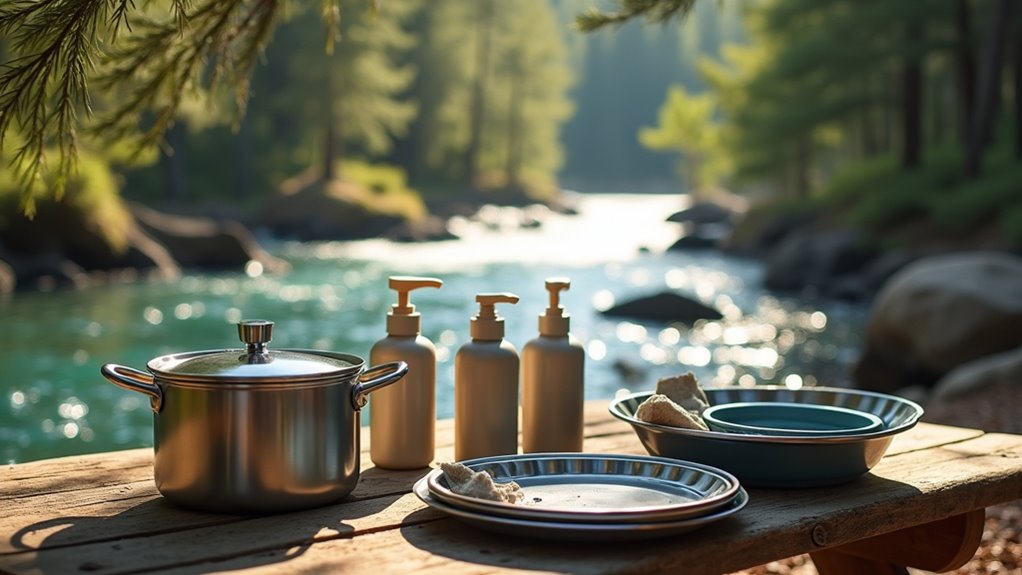
Smart campers use these 10 proven dish-cleaning techniques to maintain spotless cookware in the wilderness without modern conveniences or running water.
You’ve probably discovered that “outdoor dining cleanup” can quickly turn into a soggy nightmare when you’re miles from running water and modern conveniences. Camping doesn’t mean you’ll have to scrub dishes with lake water and hope for the best, though. Smart campers know there’s a systematic approach that’ll keep your cookware spotless while protecting the environment around you. Master these essential techniques, and you’ll transform dishwashing from your least favorite camp chore into an efficient routine.
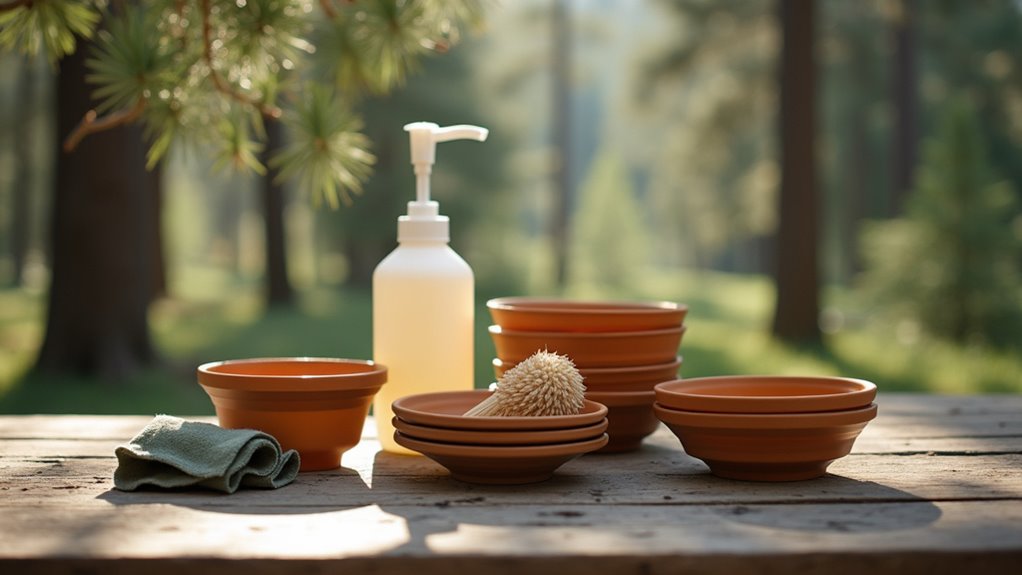
Before you head into the wilderness, you’ll want to gather essential dish-washing supplies that won’t weigh down your pack. Choose biodegradable soap that’s safe for the environment and won’t harm local water sources. Pack a lightweight scrubber or sponge—avoid steel wool that’ll scratch your cookware.
Bring a collapsible basin or large pot that doubles as a wash basin to conserve water and contain soapy water properly. Don’t forget quick-dry towels or paper towels for drying dishes efficiently. Include rubber gloves if you’re sensitive to hot water or soap.
A small bottle brush helps clean narrow-necked bottles and thermoses thoroughly. Consider packing sanitizing wipes as backup for quick cleanups. Keep everything organized in a mesh bag for easy access and quick drying. Proper dish cleaning also supports safe food storage practices by preventing bacteria buildup on cookware and utensils.
When you’re washing dishes in the wilderness, you’ll want to choose soap that breaks down naturally without harming fish, plants, or other wildlife. Regular dish soap contains phosphates and chemicals that contaminate water sources and disrupt ecosystems.
Look for soaps labeled “biodegradable” at camping stores or online. Brands like Dr. Bronner’s, Campsuds, and Sierra Dawn work effectively while protecting the environment. These concentrated formulas require only a few drops per wash.
Biodegradable camping soaps like Dr. Bronner’s and Campsuds protect wildlife while effectively cleaning dishes with just a few concentrated drops.
Even with biodegradable soap, wash dishes at least 200 feet away from streams, lakes, or rivers. The soap still needs time to break down in soil rather than entering water directly.
Strain food particles from your wash water and pack them out with your trash to prevent attracting animals.
After cleaning up your campsite, make sure to layer up with a Patagonia jacket to stay comfortable during those chilly outdoor evenings.
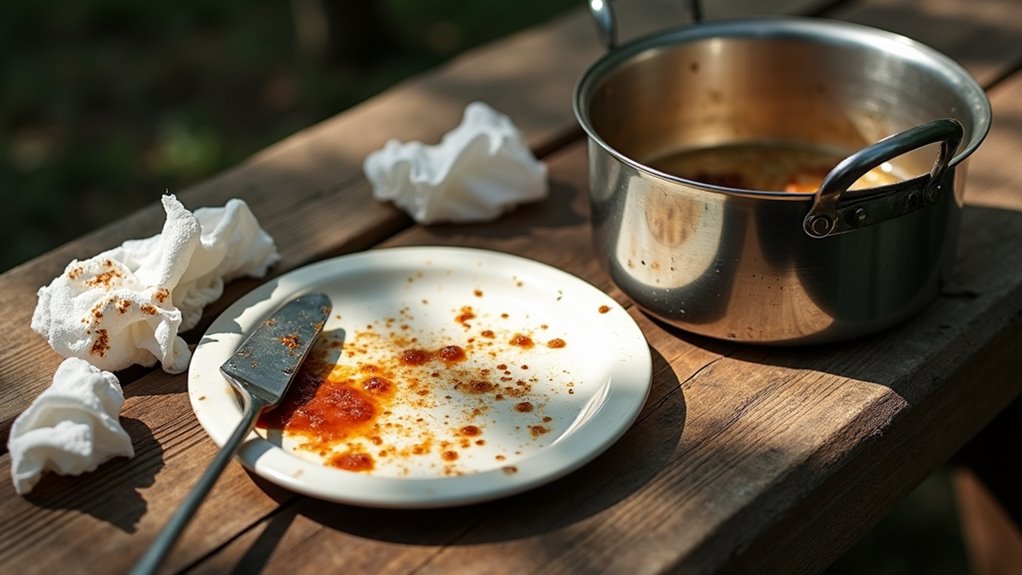
After you finish eating, grab a spatula or camp spoon and scrape every bit of food from your plates and cookware into your trash bag. This simple step saves water, prevents grease buildup, and makes washing much easier.
Next, wipe everything down with paper towels or cloth rags to remove remaining residue. You’ll be amazed how clean your dishes look before they even touch soapy water.
Here’s what you’ll need for effective pre-cleaning:
This prep work cuts your actual washing time in half while using considerably less water and soap. Keep costs down by finding affordable camping gear that serves multiple purposes for dish cleaning and food preparation.
Hot water cuts through grease and food residue far better than cold water ever could. You’ll need to heat water over your camp stove or fire to tackle greasy pans and utensils effectively. Fill a pot with water and bring it to a rolling boil, then let it cool slightly before handling.
Add a small amount of biodegradable soap to your heated water for maximum cleaning power. The combination dissolves stubborn grease that cold water simply can’t touch. Pour the hot soapy water directly onto your dishes or fill a wash basin.
Don’t waste fuel heating more water than necessary. Start with smaller amounts and heat additional water only if needed. You’ll save time and energy while achieving spotless results.
Water conservation becomes even more critical when desert camping where this precious resource is extremely limited and must be used wisely for all camp activities.
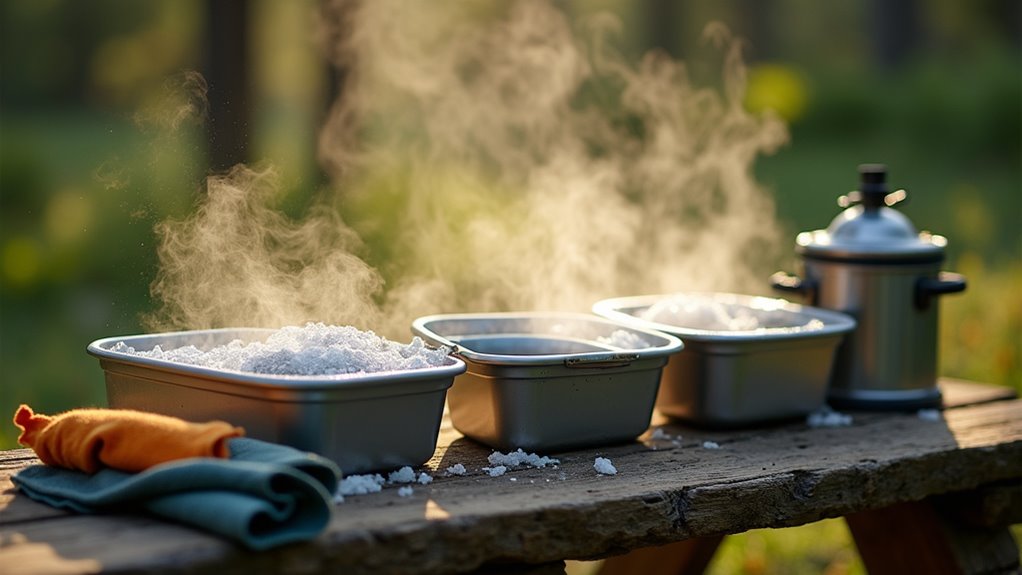
Setting up three separate basins transforms your campsite dishwashing into an efficient assembly line that’ll save you time and water. This method prevents cross-contamination and guarantees dishes get properly cleaned without endless rinsing.
Here’s how to organize your washing stations:
Move dishes from left to right through each basin. You’ll use less water than constantly refilling one container, and your dishes will be cleaner.
Large collapsible basins work best since they’re lightweight and pack small when you’re breaking camp. These essential tips will help streamline your entire camping dishwashing routine and make cleanup more manageable.
Where should you dump that soapy water once you’ve finished washing your dishes? First, strain out all food particles and pack them with your trash. Never dump greywater directly into lakes, streams, or other water sources—even biodegradable soap harms aquatic ecosystems.
Instead, dispose of greywater at least 200 feet away from any water source. Scatter it widely across the ground rather than creating one large puddle. This allows soil to filter the water naturally before it reaches groundwater.
Many established campgrounds provide designated greywater disposal sites or utility sinks specifically for this purpose. Use these facilities whenever they’re available.
If you’re camping in your RV, you’ll have onboard greywater tanks that should be emptied at proper dump stations only.
When collecting water from natural sources for dishwashing, always use a camping water filter to ensure the water is safe and clean before use.
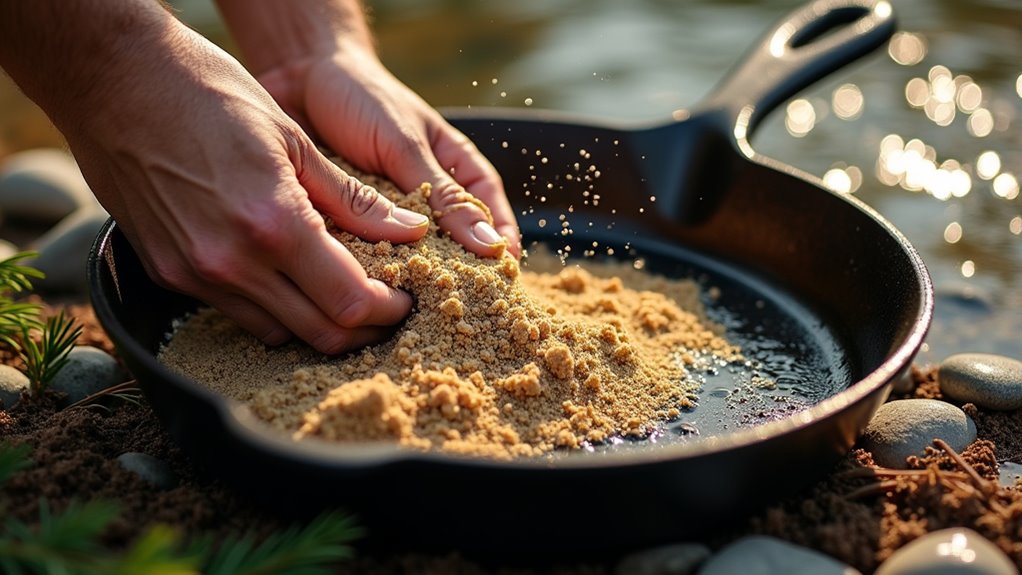
When soap and water aren’t cutting through burnt-on food or sticky residue, reach for nature’s scrubbing tools instead of harsh chemicals. Sand works exceptionally well for scouring stubborn grime without damaging your cookware or the environment.
Here’s how to use natural abrasives effectively:
Transform everyday outdoor materials into powerful cleaning tools that outperform expensive commercial products while protecting the environment.
These natural alternatives cost nothing, won’t pollute waterways, and they’re always available in outdoor settings. Whether you’re on a Snake River adventure or any wilderness camping trip, these eco-friendly cleaning methods will keep your dishes spotless without harming the pristine environments you came to enjoy.
After you’ve scrubbed your dishes clean, proper drying becomes just as essential for maintaining food safety in the wilderness. Moisture creates the perfect breeding ground for harmful bacteria, which can multiply rapidly in camping conditions.
Set up a dedicated drying area away from dirt and debris. Use a clean camp towel or bandana to remove excess water, then position dishes on a mesh rack or a clean surface with good airflow. Angle plates and bowls so water doesn’t pool in crevices.
Don’t pack wet dishes immediately – even slight dampness can lead to bacterial growth during storage. In humid conditions, consider wiping dishes with a sanitizing solution before air drying. Once completely dry, store them in clean containers or bags to maintain their sanitary condition. Remember that staying properly hydrated while handling camp chores helps you maintain focus and energy for thorough dehydration prevention practices throughout your camping trip.
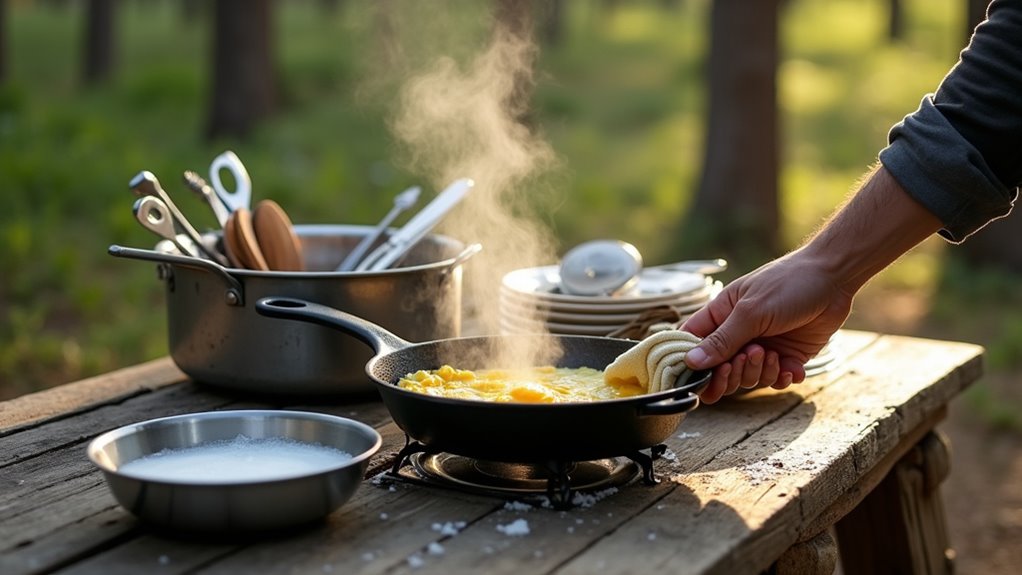
While you’re preparing meals around the campfire, tackle cleaning tasks between cooking steps to save yourself significant effort later. This approach prevents food from hardening on surfaces and makes post-meal cleanup manageable.
Here are three effective strategies:
You’ll spend less time scrubbing and more time enjoying your camping experience. These camping essentials will help establish good habits that make outdoor cooking more enjoyable and efficient for beginners and experienced campers alike.
Once you’ve finished washing your dishes, protect them from dust, insects, and overnight moisture by storing them in covered containers or sealed bags. Plastic bins with tight-fitting lids work perfectly for plates, bowls, and cups.
For lightweight camping, large ziplock bags serve the same purpose while saving space and weight.
Keep utensils in dedicated containers or wrap them in clean towels before storing. This prevents scratching and keeps everything organized for your next meal.
If you’re car camping, a mesh bag with a zipper works well for air-drying dishes before final storage.
Store your clean dish containers inside your tent or vehicle overnight. This extra step prevents curious wildlife from investigating and keeps everything ready for breakfast preparation.
Consider investing in a portable camping toilet to maintain complete campsite hygiene and complement your organized dish-cleaning routine.
Did you know that improper dishwashing while camping contributes to over 80% of waterborne illnesses in outdoor settings? You’ll drastically reduce your risk by following these simple techniques. Remember, you’re not just protecting yourself—you’re preserving the wilderness for future campers. Pack smart, scrape first, use your three-basin system, and always dispose of greywater responsibly. Clean dishes mean safe meals and a healthier camping experience for everyone.